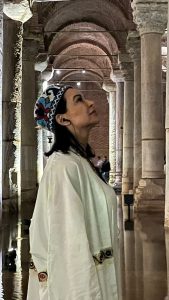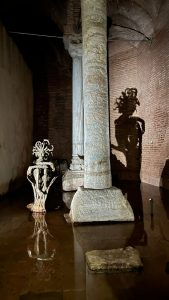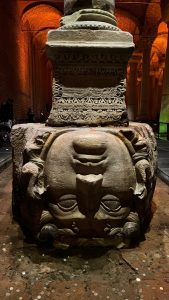Olá meus amores, dando continuidade aos lugares maravilhosos que conheci em Istambul, nesse post venho falar sobre a Cisterna Basílica, um lugar histórico, que possui uma história interessantíssima que todos, se tiver a oportunidade, deveriam visitar e aprender sobre.
Hello my loves, continuing the wonderful places I visited in Istanbul, in this post I want to talk about the Basilica Cistern, a historic place, which has a very interesting history that everyone, if they have the opportunity, should visit and learn about.
A Cisterna Basílica, também conhecida como “Palácio Submerso”, é uma das múltiplas cisternas que existem em Istambul.

As cisternas são depósitos que foram construídos para que a cidade tivesse reservas de água caso fosse atacada. Outro nome (bastante mais atraente) pelo qual é conhecida a cisterna é “Palácio Submerso”.
The Basilica Cistern, also known as the “Sunken Palace”, is one of the multiple cisterns that exist in Istanbul.
A Cisterna Basílica foi construída nos tempos de Justiniano I (527-565) para abastecer o Palácio Bizantino. A localização escolhida (à qual deve seu nome) foi o subterrâneo de uma basílica da qual já não resta nada hoje em dia.
The Basilica Cistern was built in the times of Justinian I (527-565) to supply water to the Byzantine Palace. The chosen location (to which it owes its name) was the underground of a basilica of which nothing remains today.
Para encher a cisterna se recorria aos aquedutos de Valente (ainda existentes) e de Adriano. Esses aquedutos recebiam a água dos Bosques de Belgrado, a uns 20 quilômetros de Constantinopla.

To fill the cistern, the Valente (still existing) and Adriano aqueducts were used. These aqueducts received water from the Belgrade Woods, some 20 kilometers from Constantinople.
Com 140m de comprimento e 70m de largura, o lugar impressiona, mas não está mais todo tomado pela água. Hoje existem passarelas que permitem que os visitantes caminhem entre as colunas de mármore que chegaram a abrigar mais de 100 milhões de litros de água, transportados por 20Km de aquedutos de um reservatório próximo ao Mar Negro.
At 140m long and 70m wide, the place is impressive, but it is no longer completely covered by water. Today there are walkways that allow visitors to walk between the marble columns that once housed more than 100 million liters of water, transported by 20km of aqueducts from a reservoir close to the Black Sea.
A cisterna de Yerebatan (Yerebatan Sarnıcı, seu nome em turco) tem umas dimensões de 140 por 70 metros e se calcula que poderia armazenar uns 100.000 metros cúbicos de água.
The Yerebatan cistern (Yerebatan Sarnıcı, its name in Turkish) measures 140 by 70 meters and is estimated to be able to store around 100,000 cubic meters of water.
A Basílica Cisterna tem 336 colunas de 9 metros de altura. Os estilos das colunas são muito variados, já que foram reutilizadas de antigas estruturas e monumentos.
The Cistern Basilica has 336 9-meter-high columns. The styles of the columns are very varied, as they were reused from old structures and monuments.
A necessidade da criação de um espaço tão grandioso como esse tem explicação. A Cisterna da Basílica surgiu para abastecer os palácios imperiais bizantinos e outros prédios da região. Foi também utilizada pelos Otomanos depois que esses conquistaram Constantinopla (atual Istambul), em 1453.
The need to create a space as grand as this has an explanation. The Basilica Cistern was created to supply Byzantine imperial palaces and other buildings in the region. It was also used by the Ottomans after they conquered Constantinople (now Istanbul) in 1453.
Mas depois de construírem um sistema próprio de água corrente, os Otomanos abriram mão da água estacada em uma cisterna e ela foi esquecida. Só mais de 100 anos depois, com a chegada de um viajante holandês para investigar o que havia sobrado da arte bizantina, é que a Cisterna da Basílica foi redescoberta e apresentada ao Ocidente.
But after building their own running water system, the Ottomans gave up on water stored in a cistern and it was forgotten. It was only more than 100 years later, with the arrival of a Dutch traveler to investigate what was left of Byzantine art, that the Basilica Cistern was rediscovered and presented to the West.
O passeio turístico é feito por umas passarelas que estão em cima da água. Essas passarelas foram colocadas no final do século XX, já que anteriormente o passeio era feito de barco.
The tourist tour takes place along some walkways that are above the water. These walkways were installed at the end of the 20th century, as previously the tour was done by boat.

Entre as 336 colunas da basílica há duas que têm como base uma cabeça de Medusa, o ser mitológico que transformava em pedra quem olhasse para ela.
Among the 336 columns of the basilica there are two that have as their base a head of Medusa, the mythological being who turned anyone who looked at her into stone.
Há diversas teorias sobre o que significam essas grandes cabeças no interior da cisterna, embora a teoria mais aceita é de que foram colocadas aí com fins práticos, para serem usada como base das colunas.
There are several theories about what these large heads inside the cistern mean, although the most accepted theory is that they were placed there for practical purposes, to be used as the base of the columns.

A Basílica Cisterna tem uma luz tênue, a música de fundo e o frescor que emana da água fazem dela uma visita imprescindível.
The Cistern Basilica has a dim light, the background music and the freshness emanating from the water make it an essential visit.

Fiquem sempre ligados no meu instagram @erikasantos para mais dicas como essa.
Beijos, Erika!





